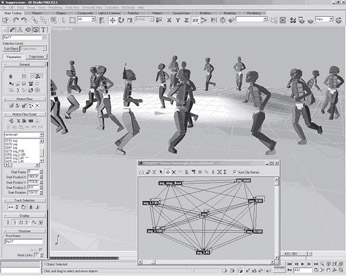3D: Discreet 3D Studio Max 5.0
|
|
3D: Discreet 3D Studio Max 5.0 (www.Discreet.com/
products/3dsmax5/)
![]()
Discreet’s 3D Studio Max (or 3DS Max) is the world’s best-selling professional 3D modeling animation and rendering application. 3DS Max delivers a unified object-oriented platform for the artists designing visual effects, character animation, and state-of-the-art games.
3DS Max has won over 65 industry awards since its first publication in 1996 and has sold over 140,000 copies on the Windows platform. Now Microsoft’s Xbox and PlayStation 2 artists can utilize 3DS Max.

System requirements for Windows include the Windows 2000 or 98 operating systems with a 300 MHz processor minimum (dual Pentium 3 system recommended), 128 MB RAM and 300 MB swap space minimum, graphics card supporting 1024x768x16-bit color (OpenGL and Direct3D hardware acceleration supported, 24-bit color, 3D graphics accelerator is preferred), mouse (optimized for Microsoft’s Intellimouse), CD-ROM drive, optional sound card, and speakers. Network rendering supported for Windows 2000 only.

3DS Max supports numerous image file formats, such as AVI, BMP, CIN, EPS, FLC, GIF (import only), JPG, PNG, RGB, RLA, RPF, TGA, TIF, YUV (import only), Photoshop PDS (import only), and QuickTime MOV. The geometry file support includes IGES (import only), PRJ, SHP, VRML, 3DS, 3D ASCII SCENE, Adobe Illustrator AI, AutoCAD DWG and DXF, Adobe Type 1 (import only), and TrueType fonts (import only).
Some interesting new features of 3DS Max version 4.0 are flexible IK independent shaded bones system for more accurate skeletal setups, previews, and skinning, and IK support of branching hierarchies, pinned objects, and six degrees of freedom (6DOF) constraints.
Character deformations include new angle deformers and soft body characteristics. Other features include game development support for Direct3D, multi textures per face, opacity mapping, true transparency, and pixel/vertex shaders like reflection maps and bump maps. An “animate” button makes everything clicked on virtually animated. Shaders provided include isotropic, Blinn, Oren-Nayar-Blinn, Phong, metal, multilayer, and Strauss with independent sampler options.
NURBS can be projected onto mesh surfaces. NURBS surfaces include point and CV, u-loft, uv-loft, blend, n-sided blend, offset, extrude, fillet, lathe, ruled, cap, one rail, two rail, trim, and multi-curve trim. NURBS curves include point and CV, fit, offset, chamfer, fillet, surface-surface intersection, surface edge, ISO, curve on surface, and projected with trimming control.
The particle system has behavioral control, such as inter-particle collision, meta-particles, snow, spray, bubbles, explosions, spawning, and trails that support dynamic reactions with forces and object collisions. Interchangeable light types include omni, free and target spot, free and target directional that support plug-in shadows, shadow color and density, projected images, contrast, edge softness, attenuation, and decay.
Discreet’s 3DS Max 5.0 includes new bone tools, character node function, set-key animation, skin pose, morphing, spline IK, function curve and dope sheet editors, integrated dynamics, and weighted controllers. Other new features include a redesigned UV interface and new polygonal modeling tools.
3DS Max 5 is available for Windows 2000 and XP and retails for $3,195 with an option to upgrade from Max 4 for $795 or from Max 3 for $995.
|
|
EAN: 2147483647
Pages: 179